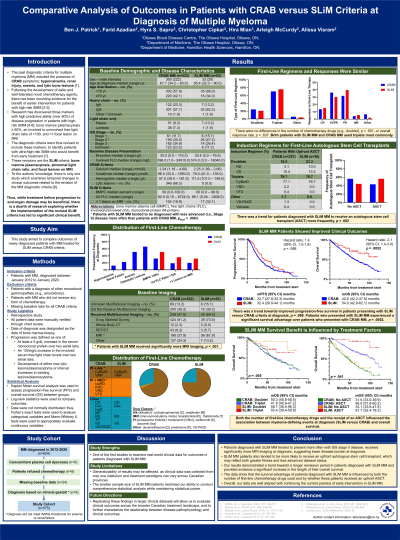Treatment of Newly Diagnosed Myeloma - Transplant Eligible
Poster Session 1
P-155: Comparative Analysis of Outcomes in Patients with CRAB versus SLiM Criteria at Diagnosis of Multiple Myeloma
Wednesday, September 27, 2023
1:30 PM - 2:30 PM EEST


Benjamin J. Patrick, MSc
Research Coordinator
Ottawa Hospital Research Institute
Milton, Ontario, Canada
Introduction: In 2014 the International Myeloma Working Group (IMWG) redefined the multiple myeloma (MM) diagnostic criteria to include ultra-high risk smoldering MM patients (those with “SLiM” criteria of bone marrow plasma cell burden (BM PC) >60%, >1 focal lesion on MRI, or a free light chain (FLC) ratio ≥100 with involved FLC >100 mg/L). However, there is a paucity of data to examine the real-world health outcomes of patients initially presenting with end-organ damage (“CRAB”: hypercalcemia, anemia, renal failure, or osteolytic bone lesions) versus SLiM criteria. Therefore, this study aimed to compare the progression-free survival (PFS) and overall survival (OS) between patients with only SLiM versus CRAB criteria at MM diagnosis.
Methods: This retrospective study included patients diagnosed with MM between January 2016 to December 2022 at the Ottawa Hospital. Time to event analyses using the Kaplan-Meier method were used to evaluate the median PFS (primary endpoint) and median OS (secondary endpoint), defined from the time of initiating first line therapy for MM. Overall response rate (ORR) was defined as achieving a partial response or better. Nonparametric methods were used to compare baseline demographic and treatment characteristics of SLiM versus CRAB patients.
Results: Overall, 617 MM patients were included in the study (49 [8%] with SLiM MM and 567 [92%] with CRAB MM). Among patients with CRAB MM, the most common presentation was osteolytic lesions (n=340, 60%), anemia (n=269, 47%), renal failure (n=118, 21%), then hypercalcemia (n=63, 11%), as defined by the IMWG (Rajkumar et al. Lancet Oncol. 2014). Among SLiM MM patients, the most common treatment indications were BM PC >60% (n=21, 42.9%), FLC ratio ≥100 (n=13, 26.5%), followed by focal lesions on MRI (n=13, 26.5%). SLiM versus CRAB MM patients had similar ages at diagnosis (median age 67.3 versus 67.5 years, respectively, p=0.889) and similar proportions of patients with ISS stage 3 disease at diagnosis (33% versus 26.5%, respectively, p=0.076). Treatment of SLiM versus CRAB patients was similar; immunomodulatory drugs or proteosome inhibitors were used in first line treatment in 90% versus 92% of patients (p=0.578), and 49% versus 44% of patients received an upfront transplant (p=0.553). SLiM versus CRAB MM patients had a similar PFS (median PFS 36.9 versus 31.8 months, respectively, p=0.365) and ORR (89% in both groups, p=0.964). However, there was a trend towards longer OS among patients presenting with SLiM versus CRAB MM (median PFS 99.5 versus 66.7 months, respectively, p=0.070).
Conclusions: Despite similar baseline demographics and treatments, we found a trend towards improved survival among patients treated for SLiM MM. Further work is needed to identify whether survival benefits are due to persistence of less resistant clones leading to longer PFS at relapse. However, these real-world data support the current practice of early intervention in patients with SLiM MM.
Methods: This retrospective study included patients diagnosed with MM between January 2016 to December 2022 at the Ottawa Hospital. Time to event analyses using the Kaplan-Meier method were used to evaluate the median PFS (primary endpoint) and median OS (secondary endpoint), defined from the time of initiating first line therapy for MM. Overall response rate (ORR) was defined as achieving a partial response or better. Nonparametric methods were used to compare baseline demographic and treatment characteristics of SLiM versus CRAB patients.
Results: Overall, 617 MM patients were included in the study (49 [8%] with SLiM MM and 567 [92%] with CRAB MM). Among patients with CRAB MM, the most common presentation was osteolytic lesions (n=340, 60%), anemia (n=269, 47%), renal failure (n=118, 21%), then hypercalcemia (n=63, 11%), as defined by the IMWG (Rajkumar et al. Lancet Oncol. 2014). Among SLiM MM patients, the most common treatment indications were BM PC >60% (n=21, 42.9%), FLC ratio ≥100 (n=13, 26.5%), followed by focal lesions on MRI (n=13, 26.5%). SLiM versus CRAB MM patients had similar ages at diagnosis (median age 67.3 versus 67.5 years, respectively, p=0.889) and similar proportions of patients with ISS stage 3 disease at diagnosis (33% versus 26.5%, respectively, p=0.076). Treatment of SLiM versus CRAB patients was similar; immunomodulatory drugs or proteosome inhibitors were used in first line treatment in 90% versus 92% of patients (p=0.578), and 49% versus 44% of patients received an upfront transplant (p=0.553). SLiM versus CRAB MM patients had a similar PFS (median PFS 36.9 versus 31.8 months, respectively, p=0.365) and ORR (89% in both groups, p=0.964). However, there was a trend towards longer OS among patients presenting with SLiM versus CRAB MM (median PFS 99.5 versus 66.7 months, respectively, p=0.070).
Conclusions: Despite similar baseline demographics and treatments, we found a trend towards improved survival among patients treated for SLiM MM. Further work is needed to identify whether survival benefits are due to persistence of less resistant clones leading to longer PFS at relapse. However, these real-world data support the current practice of early intervention in patients with SLiM MM.
